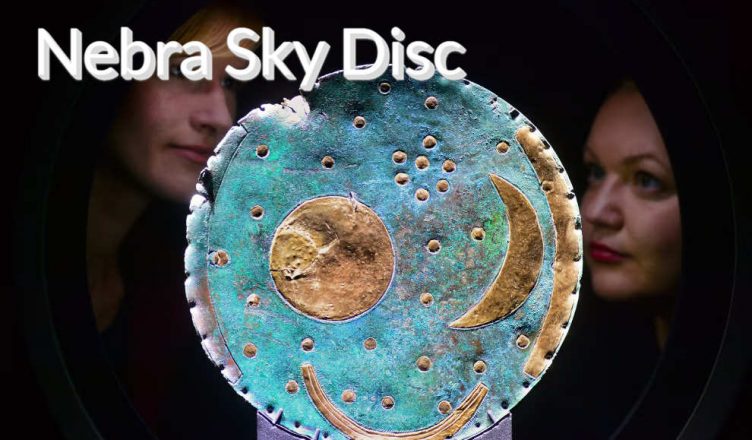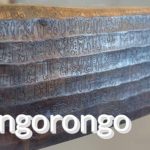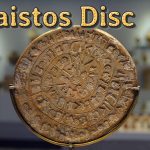Nestled deep within the annals of ancient history, a remarkable artifact emerged from the sands of time, sending ripples through the worlds of archaeology, astronomy, and beyond. This artifact, known as the Nebra Sky Disc, is a dazzling enigma that has ignited the flames of curiosity and controversy for decades. Its origin, purpose, and significance have intrigued scholars and the general public alike.
In this exploration, we embark on a journey to unravel the mysteries surrounding the Nebra Sky Disc. With its gleaming bronze surface adorned with celestial symbols and enigmatic patterns, it is a relic that stands as a testament to the brilliance and intrigue of our distant ancestors. From its discovery by treasure hunters to debates about its authenticity and age, we delve into ten fascinating facts that paint a vivid picture of this ancient masterpiece.
1. The Mystery of the Metal Disk on a German Ancient Battlefield:
In 1999, a group of German “treasure hunters” using metal detectors discovered numerous bronze weapons, including a metal disk, near the ancient battlefield in Nebra, Saxony-Anhalt, Germany. At the time, no one knew the purpose of this metal disk.
In 2002, the metal disk made its way into the antiquities market, and its value skyrocketed to hundreds of thousands of euros. German police took action, arresting the so-called “treasure hunters” and ordered them to lead archaeologists to the site where the disk was found.
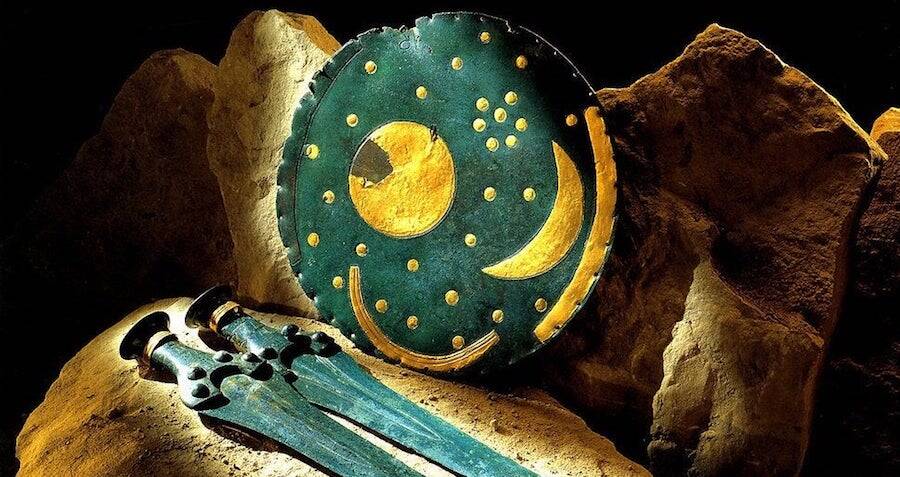
The discovery of the disk immediately ignited great enthusiasm in the European archaeological and astronomical communities. Many scientists joined in the discussion and research. They ultimately concluded that “the metal disk is a bronze artifact used to record ancient celestial phenomena and named it the ‘Nebra Sky Disc.'”
2. A Source of German Pride and Controversy Combined:
With its shimmering green surface, golden circular symbols, and surrounding golden arcs, the Nebra Sky Disc is not only a national treasure of Germany but also one of the oldest surviving depictions of the night sky and a UNESCO-certified “one of the most important archaeological discoveries of the 20th century.” However, it is also a source of endless controversy.
Previously, it was believed that the Nebra Sky Disc was created during the Bronze Age, around 3,600 years ago. But recently, two German archaeologists, Rupert Gebhard and Rüdiger Krause, argue that the disc’s creation is not so ancient and dates back to the Iron Age, approximately 2,600 years ago. This significant reduction in its historical age by 1,000 years immediately sparked a heated debate within the German archaeological community.
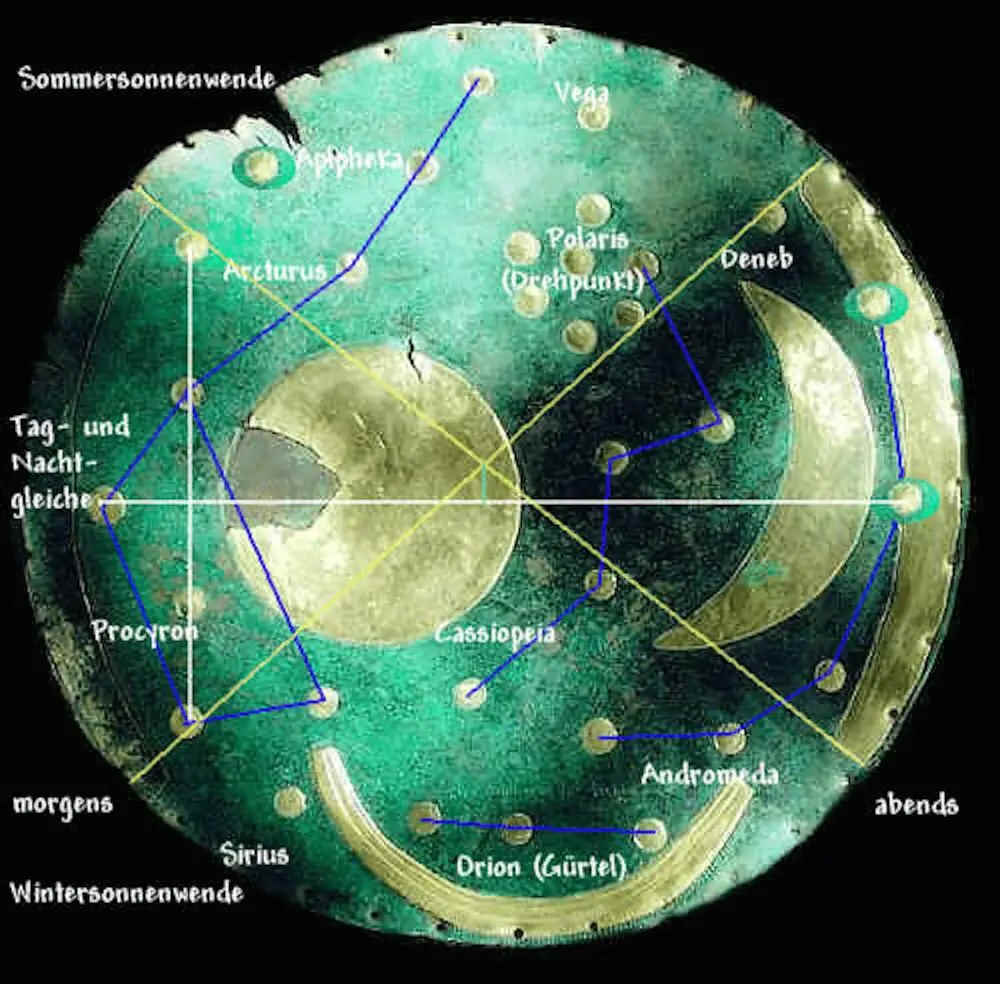
3. A Valuable Aid for Astronomical Observation:
The Nebra Sky Disc is composed of 30 small dots representing stars, a large circle symbolizing the sun or full moon, symbols for the crescent moon, and arcs. Scientists speculate that the Nebra Sky Disc was likely a tool for observing the movements of the sun and moon, aiding farmers in planning their agricultural activities.
Jan-Heinrich Bunnefeld, an archaeologist at the Saxony-Anhalt State Museum for Prehistory, which houses the Nebra Sky Disc, stated, “Whether in the fields of archaeology, astronomy, or religious history, the Nebra Sky Disc is a significant artifact.”
4. The Ancient Celestial Mystery and the Fascinating History of the Pleiades:
The Nebra Sky Disc is a bronze circular disk with a diameter of 32 centimeters, a thickness of about 1 centimeter, and a weight of approximately 2 kilograms. It is covered with green-blue copper patina, with faintly visible inlays of gold. The disk features inlaid gold circular dots and arc-shaped patterns, with the largest circular symbol believed to represent the sun.
In total, 23 “stars” are inlaid with gold on the disk, and their positions appear somewhat random, with little apparent significance. However, the particular group of seven stars in the upper right corner drew the attention of scientists. These seven clustered stars are considered to be the Pleiades star cluster.
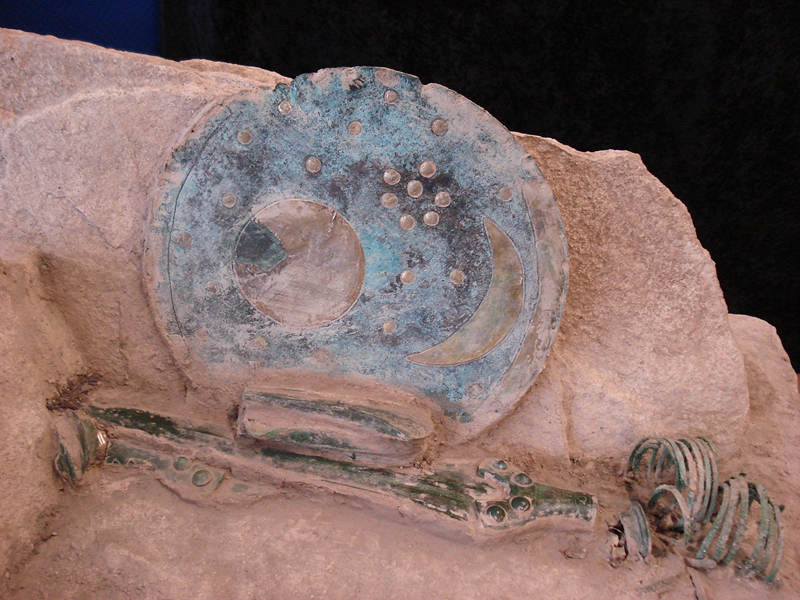
In ancient Europe, the Pleiades would appear prominently in the southeastern sky during the autumn and winter harvesting seasons, making it a striking celestial feature. In the Northern Hemisphere, most people could see six stars in the Pleiades with the naked eye. However, during the Bronze Age, all seven stars were clearly visible, and these seven stars were known as the “Seven Sisters” by the ancient Greeks.
The Pleiades were an important constellation in many ancient civilizations, serving as a significant marker in the astronomy and calendars of ancient Western, Babylonian, and Eastern cultures. Interestingly, around 1600 BC, the vernal equinox coincided with the vicinity of the Pleiades, which suggests that the Nebra Sky Disc may depict the celestial configuration of the vernal equinox.
5. The Sun and the Mysterious Symbols of Ancient Celestial Observations:
German ancient astronomer Professor Schlosser measured the Nebra Sky Disc near the town of Nebra and discovered that two of the arc-shaped elements on the disk indicate the directions of the sun’s rising and setting on the summer solstice and winter solstice. If you draw diagonals from the top of one arc to the bottom of the opposite arc, the intersection of these diagonals precisely aligns with the center of the disk. Furthermore, the angle between these two diagonals is exactly 82 degrees, reflecting the angle between the sun’s positions during the local summer and winter solstices.
The last addition, in the form of a metal inlay at the bottom of the disk, features numerous curved engravings whose meaning remains undetermined. Scientists speculate that it may represent a solar ship, with the engravings symbolizing oars or possibly the Milky Way, a rainbow, or other celestial phenomena.
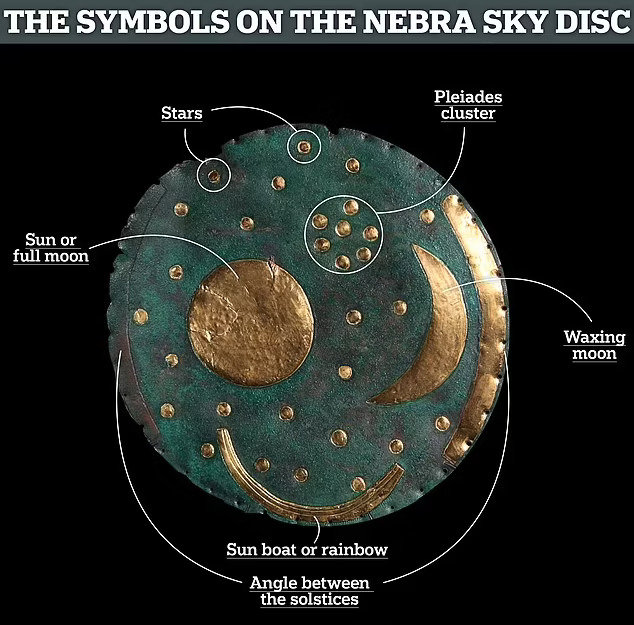
6. The Solar Ship and Mysterious Holes:
Ancient Europeans believed that after the sun set in the west, it would be carried by a ship to the east, where it would rise again. The hair-like protrusions around the edges of the disk are thought to represent the oars of this solar ship. This depiction of the solar ship is one of the earliest known artistic representations of this concept.
Several small holes are scattered along the edge of the disk, but the purpose of these holes remains unknown to scientists. Some speculate that ancient people may have used specific holes for calibrating the positions of stars, enabling them to deduce changes in seasonal events. However, others suggest that these holes may have had purely decorative purposes.
7. Evolution of the Production Process and Religious Integration:
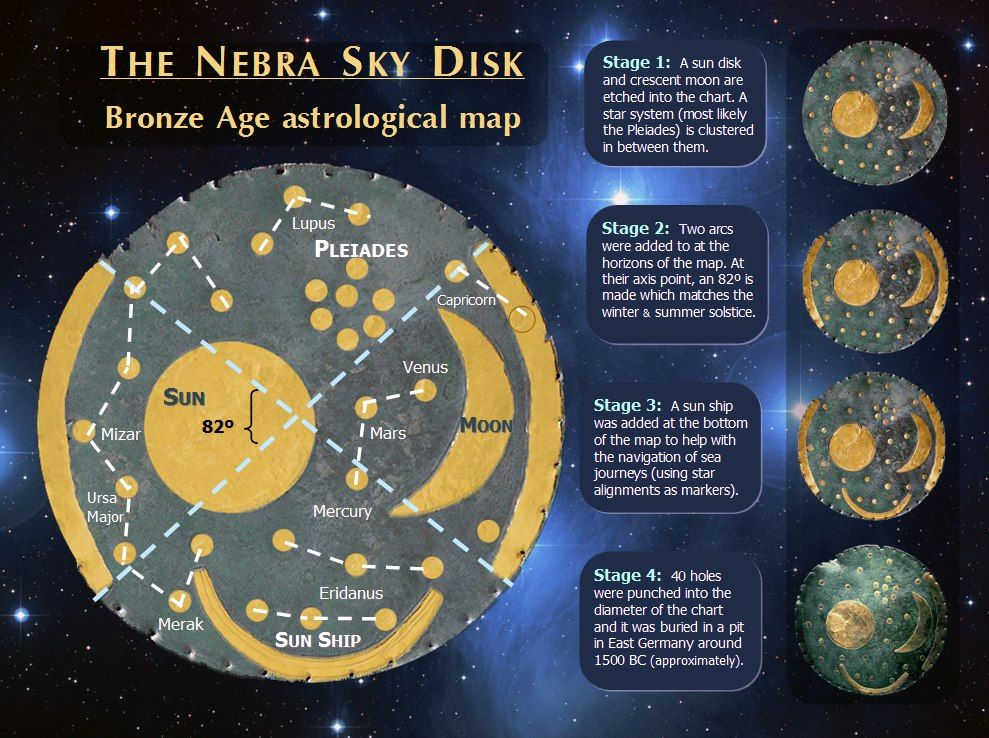
The production of the Nebra Sky Disc occurred in three distinct phases, each marked by notable differences in time. This suggests that its actual purpose underwent continuous changes during its transmission. Additionally, the addition of the solar ship at the bottom of the disc hints at a possible religious significance.
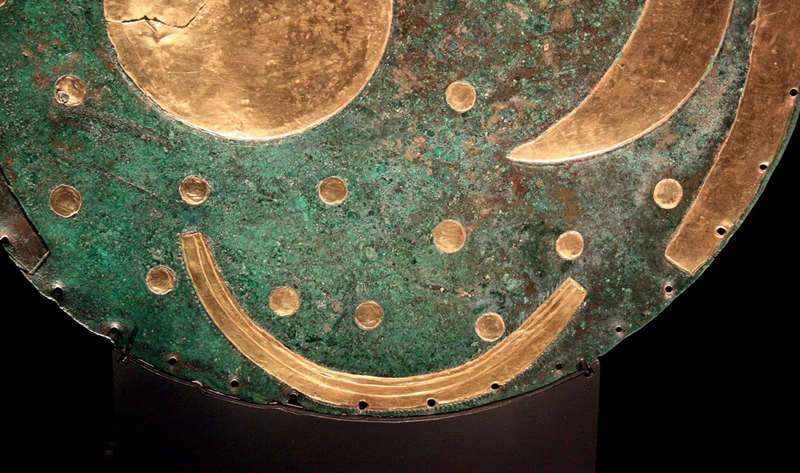
The European “Bronze Age,” similar to China’s Bronze Age, was situated within an agricultural society. To accurately estimate the timing of planting and harvesting, people needed to create astronomical calendars based on celestial observations and preserve them using the most advanced methods available at the time.
8. The Controversy of the “Forgery Debate” Surrounding the Nebra Sky Disc:
To this day, there are many skeptics who doubt the authenticity of the Nebra Sky Disc, suggesting that it might be a modern creation. Professor Peter Schorr of the University of Regensburg in Germany claimed that the copper patina on the Nebra Sky Disc was forged and that he could replicate the same “excavated artifact” using urine, hydrochloric acid, and an alcohol torch. Oddly enough, he stated in court that he had never actually touched the Nebra Sky Disc.
Professor Richard John Harrison of the University of Bristol and an expert in the Corded Ware culture were quoted in a BBC documentary regarding their thoughts on the Nebra Sky Disc: “When I first heard about the Nebra Sky Disc, I thought it might be a joke, that it might be a forgery. A skilled antiquities forger could produce such a fake in a short time and sell it for a large sum of money.”
Nevertheless, Professor Harrison, when interviewed, stated that he had not seen the disc, and his skepticism was reasonable. At present, most scientists widely accept the authenticity of the Nebra Sky Disc based on the dating of other artifacts found in conjunction with it, which indicates a date around 1600 BC. Additionally, microscopic analysis has confirmed the presence of corrosion and crystallization on the disc, which is not something forgers could easily reproduce, further solidifying the authenticity of the Nebra Sky Disc.
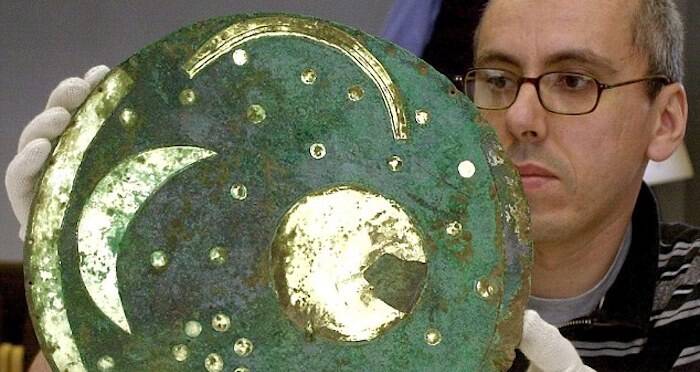
9. Not Found on the Mittelberg Hill?
In addition to the debate over the age of the Nebra Sky Disc, Rupert Gebhard, the head of the Bavarian State Collection for Archaeological Monuments, and Klaus Rüdiger Krause, a professor of European Prehistory and Early History at the University of Frankfurt, have proposed that the Nebra Sky Disc was not found on Mittelberg Hill in Saxony-Anhalt. Their assertion stems from analyses involving isotopes, soil, and iconography.
Their argument has some basis since the Nebra Sky Disc was not excavated under strict archaeological protocols but was discovered by two treasure hunters in 1999, along with other artifacts. Shortly after its discovery, the treasure hunters attempted to sell the disc on the black market, and it wasn’t until 2002 that the disc was recovered. The treasure hunters were sentenced in 2005, but they agreed to cooperate with German authorities, leading experts to the site they claimed was the original discovery location on Mittelberg Hill.
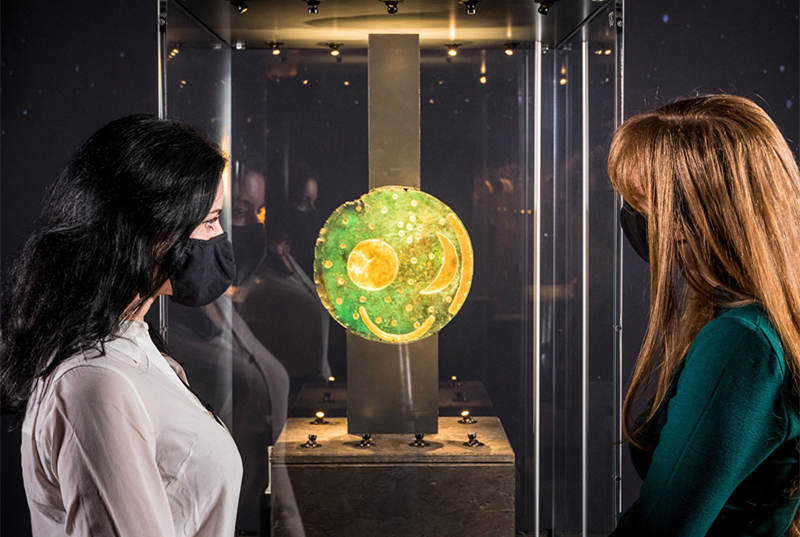
10. The Archaeological Mystery and Ongoing Controversies:
In the eyes of Emilia Pásztor, a historian at the Türr István Museum in Hungary, the research by Gebhard and Krause is not sufficient to conclusively date the Nebra Sky Disc to the Iron Age. Nevertheless, the minimalist symbols on the disc do not match common Bronze Age patterns, especially the crescent moon symbol, which rarely appears on Bronze Age artifacts.
Pásztor commented, “Both sides offer evidence that is not entirely convincing. When an artifact in a museum comes from the hands of treasure hunters, no one can easily confirm anything.”
“Before more precise dating methods are developed, the background of the Nebra Sky Disc’s discovery has guaranteed its status as a controversial artifact,” Pásztor said. In response to challenges from other archaeologists, Gebhard maintains an optimistic attitude and looks forward to open discussions with colleagues in the field, stating, “We are very much looking forward to further scientific discussions on the Nebra Sky Disc with the archaeological community and our colleagues at the State Museum for Prehistory. The Nebra Sky Disc is a fascinating artifact that indeed requires more open discussions.”
END:
The Nebra Sky Disc is not only a testament to the ingenuity and astronomical curiosity of our ancestors but also a symbol of human resilience in the face of skepticism and controversy. With the continuous advancement of scientific methods and technology, we can only anticipate that more revelations and insights await us.
In the future, this ancient masterpiece will likely continue to inspire astronomers, archaeologists, and scholars from various fields, fostering collaborative efforts to understand the celestial insights it encapsulates. The Nebra Sky Disc serves as a bridge connecting our modern world with the wisdom of ancient civilizations, reminding us that there is still much to discover in the vast tapestry of history.
More UFOs and mysterious files, please check out our YouTube channel: MysFiles
Is the moon artificial? Evidence Proves the Moon Was Unnaturally Formed
